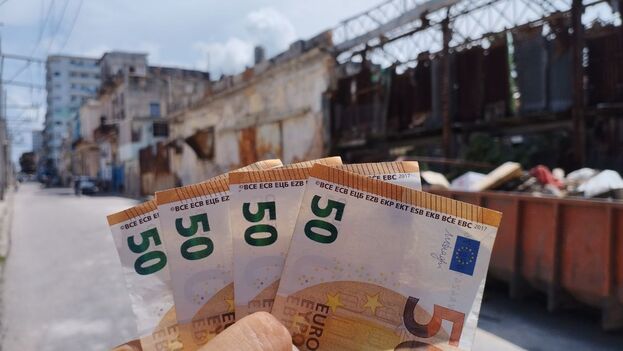
![]() 14ymedio, Natalia, López, Moya, Havana, 4July 2022 — The price of foreign currencies in Cuba is unstoppably taking flight again after the decline they experienced at the end of May. Among them, the euro once again outperforms the dollar by far. A euro is worth around 123 pesos in the informal market this Monday, compared to the 110 that the dollar costs, according to daily monitoring by the independent magazine El Toque.
14ymedio, Natalia, López, Moya, Havana, 4July 2022 — The price of foreign currencies in Cuba is unstoppably taking flight again after the decline they experienced at the end of May. Among them, the euro once again outperforms the dollar by far. A euro is worth around 123 pesos in the informal market this Monday, compared to the 110 that the dollar costs, according to daily monitoring by the independent magazine El Toque.
The figure contrasts with the international price of the European currency, which has fallen in recent months against the dollar (this Monday it is at 1.04 per dollar).
“I prefer to buy euros because I have plans to leave the country, but not immediately,” Nelson, a young man from the Havana municipality of Cerro, tells this newspaper, summarizing the needs of many other Cubans. Nelson explains that in case he needs the currency to be able to shop in freely convertible currency (MLC) stores, he can deposit those euros on his magnetic card, which he cannot do with dollars. And he adds: “In case you need to buy a ticket or manage a visa for Panama, I can also use it.”
During the month of June, after a resolution by the Central Bank of Cuba that prohibited embassies from converting their peso accounts into foreign currency, several consulates, such as those of Spain or Panama, announced that from now on, the procedures at their headquarters would be charged in euros.
The value of the MLC is also experiencing an increase, something that has relieved many families who obtain remittances from abroad and who over the past month saw their purchasing power reduced between the low price of the currency and inflation on the Island, which continues upward.
“As soon as I saw that it was starting to rise, I asked my family to please stop selling the MLCs that I sent so cheaply and to wait,” says Liuba, a Cuban living in Miami. “Two weeks ago my mother sold them for 108 and today she was able to sell them for 115.”
Last May, currencies suffered a collapse in the informal market, just after the Cuban Economy Minister, Alejandro Gil Fernández, declared that a “special” exchange rate would be established for some producers, state and private, of consumer goods. high demand.
Without specifying at what price, he simply pointed out that it would be between the artificial official rate of 24 pesos and that of the black market, which in those days reached 125 pesos for MLC.
Traditionally more familiar with the dollar, informal vendors have quickly caught up with the European currency to spot counterfeits and reject bills that may have trouble being deposited at the bank. “I do not accept those that have written signs, some broken part or are very old,” replies one of those money changers in a WhatsApp group used by customers and merchants.
Many private businesses have also joined the euro wave and offer their cards in three or even four currencies. “In this restaurant you can pay in Cuban pesos, MLC, dollars and euros,” a waiter from a paladar (private restaurant) on San Lázaro street in Central Havana boasted this Saturday. “You can even pay in pesos and MLC by transfer. We are pricing the euro at 117 pesos,” he stressed. Two tourists who drank a couple of beers each and ate some starters settled their bill, 17.70 euros with a 20 euro bill. The change, “in Cuban pesos,” the employee clarified.
____________
COLLABORATE WITH OUR WORK: The 14ymedio team is committed to practicing serious journalism that reflects Cuba’s reality in all its depth. Thank you for joining us on this long journey. We invite you to continue supporting us by becoming a member of 14ymedio now. Together we can continue transforming journalism in Cuba.
